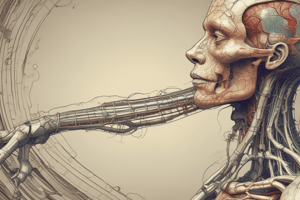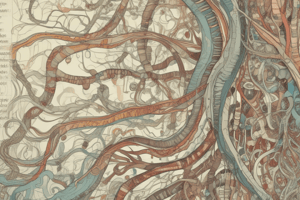Podcast
Questions and Answers
Which type of receptor is primarily responsible for smooth muscle contraction in visceral organs?
Which type of receptor is primarily responsible for smooth muscle contraction in visceral organs?
- α1 (correct)
- β2
- Nicotinic AChR
- β1
What is the primary function of the postganglionic neuron in the sympathetic nervous system?
What is the primary function of the postganglionic neuron in the sympathetic nervous system?
- Release of Noradrenaline (NA) (correct)
- Release of IP3/DAG
- Release of ACH
- Preganglionic stimulation
Which receptor is associated with vasodilation in skeletal muscle?
Which receptor is associated with vasodilation in skeletal muscle?
- β1
- α1
- Nicotinic AChR
- β2 (correct)
What is the effect of sympathetic nervous system stimulation on the heart?
What is the effect of sympathetic nervous system stimulation on the heart?
Which of the following is NOT a function of the sympathetic nervous system?
Which of the following is NOT a function of the sympathetic nervous system?
What is the primary neurotransmitter released by the preganglionic neuron?
What is the primary neurotransmitter released by the preganglionic neuron?
Which nerve is responsible for ciliary muscle contraction and accommodation?
Which nerve is responsible for ciliary muscle contraction and accommodation?
What is the effect of muscarinic receptors on the heart rate?
What is the effect of muscarinic receptors on the heart rate?
Which of the following is NOT a function of the muscarinic receptor subtype M1?
Which of the following is NOT a function of the muscarinic receptor subtype M1?
What is the effect of muscarinic receptors on the liver?
What is the effect of muscarinic receptors on the liver?
What is the effect of muscarinic receptors on the stomach and intestines?
What is the effect of muscarinic receptors on the stomach and intestines?
Which of the following is a function of the muscarinic receptor subtype M2?
Which of the following is a function of the muscarinic receptor subtype M2?
What is the effect of muscarinic receptors on blood pressure?
What is the effect of muscarinic receptors on blood pressure?
What is the effect of muscarinic receptors on the trachea and bronchi?
What is the effect of muscarinic receptors on the trachea and bronchi?
What type of receptors are present in sweat glands, despite being innervated by the sympathetic nervous system?
What type of receptors are present in sweat glands, despite being innervated by the sympathetic nervous system?
What is the effect of a muscarinic agonist on vessels?
What is the effect of a muscarinic agonist on vessels?
What is the result of blocking the parasympathetic nervous system with a muscarinic antagonist, such as atropine?
What is the result of blocking the parasympathetic nervous system with a muscarinic antagonist, such as atropine?
What is the equation used to describe the relationship between ion distribution and membrane potential?
What is the equation used to describe the relationship between ion distribution and membrane potential?
What is the characteristic of the cardiac action potential in ventricular myocytes?
What is the characteristic of the cardiac action potential in ventricular myocytes?
What is the difference between cardiac action potential in ventricular myocytes and pacemaker cells?
What is the difference between cardiac action potential in ventricular myocytes and pacemaker cells?
What is the result of muscarinic effects on the eye?
What is the result of muscarinic effects on the eye?
What is the term for anti-muscarinic effects?
What is the term for anti-muscarinic effects?
What is the effect of digitalis on calcium exchange?
What is the effect of digitalis on calcium exchange?
What is the result of increased [Ca++]i in the heart?
What is the result of increased [Ca++]i in the heart?
What is the mechanism by which digitalis increases vagal tone?
What is the mechanism by which digitalis increases vagal tone?
What is the effect of atropine on the heart rate?
What is the effect of atropine on the heart rate?
Which of the following drugs has negative chronotropic side effects?
Which of the following drugs has negative chronotropic side effects?
What is the effect of digitalis on the effective refractory period (ERP)?
What is the effect of digitalis on the effective refractory period (ERP)?
Which of the following drugs acts on voltage-gated calcium channels?
Which of the following drugs acts on voltage-gated calcium channels?
How do you treat bradycardia?
How do you treat bradycardia?
What is the primary mechanism behind the slow depolarization from -60 mV (pacemaker potential)?
What is the primary mechanism behind the slow depolarization from -60 mV (pacemaker potential)?
What is the name of the channel responsible for the If current?
What is the name of the channel responsible for the If current?
What is the primary action of Class I anti-dysrhythmic drugs?
What is the primary action of Class I anti-dysrhythmic drugs?
What is the characteristic of Class Ib anti-dysrhythmic drugs?
What is the characteristic of Class Ib anti-dysrhythmic drugs?
What is the effect of Class I drugs on pacemaker potentials?
What is the effect of Class I drugs on pacemaker potentials?
What is a common side effect of Class I anti-dysrhythmic drugs?
What is a common side effect of Class I anti-dysrhythmic drugs?
What is the characteristic of Class Ia anti-dysrhythmic drugs?
What is the characteristic of Class Ia anti-dysrhythmic drugs?
What is the primary indication for Class I anti-dysrhythmic drugs?
What is the primary indication for Class I anti-dysrhythmic drugs?
Flashcards are hidden until you start studying
Study Notes
Autonomic Nervous System Effects on Heart and Other Organs
- The sympathetic nervous system has a preganglionic neuron that releases ACH, which acts on nicotinic ACH receptors.
- The postganglionic neuron releases noradrenaline (NA), which acts on different adrenergic receptors (AR) at end organs.
Adrenergic Receptors
- α1 receptors: smooth muscle contraction, vasoconstriction in viscera, and GI motility.
- β1 receptors: heart frequency, contractile force, and conduction at A-V node.
- β2 receptors: smooth muscle relaxation, vasodilation in skeletal muscle, and bronchi dilation.
Sympathetic Nervous System: Adrenergic Receptors
- Preganglionic neurons release ACH, which acts on nicotinic ACH receptors.
- Postganglionic neurons release NA, which acts on different AR at end organs.
- Effects of sympathetic nervous system on different organs:
- Eyes: pupillary dilation.
- Heart: increased heart rate.
- Lungs: bronchi dilation.
- Liver: increased glycogenolysis.
- Stomach and intestines: increased motility and secretions.
- Arteries and veins: increased blood pressure and redistribution of blood flow away from GI tract.
Muscarinic Acetylcholine Receptors
- ACH release and breakdown by ACH esterase.
- Muscarinic receptors:
- M1: IP3/DAG signaling in CNS, glands, and smooth muscle.
- M2: cAMP signaling in heart and CNS.
- M3: IP3/DAG signaling in smooth muscle and glands.
- M4: cAMP signaling in smooth muscle and glands.
- M5: IP3/DAG signaling in smooth muscle and glands.
- Effects of muscarinic receptors:
- SLUDGE (Salivation, Lacrimation, Urination, Defecation, Gastrointestinal motility, and Emesis) or DUMBELS (Diarrhea, Urination, Miosis, Bronchorrhea, Bronchospasm, and Emesis).
Anti-Dysrhythmic Drugs
- Classification of anti-dysrhythmic drugs according to the Vaughan Williams system:
- Class I: sodium channel blockers.
- Class II: β-adrenoreceptor antagonists.
- Class III: drugs that prolong the cardiac action potential.
- Class IV: calcium channel antagonists.
Class I – Na+ Channel Blockers
- Mechanism of action: block voltage-sensitive sodium channels.
- Effects: slow conduction velocity of pacemaker potentials throughout the heart and affect myocyte action potentials.
- Used for: ventricular and atrial tachyarrhythmias.
- Side effects: bradycardia and potential worsening of arrhythmias.
- Subclasses:
- Ia: dissociation within < 0.5 sec.
- Ib: highly frequency-dependent, used for bradyarrhythmia (i.v.).
Digitalis
- Used for heart failure and some arrhythmias to increase ventricular output.
- Mechanism of action:
- Inhibition of NaK-ATPase, leading to increased [Na+]i and [Ca++]i.
- Increased vagal tone, leading to cardiac slowing and reduced rate of conduction through AV node.
- Increased [Ca++]i, leading to increased twitch tension and increased chance of afterdepolarisations and tachycardia.
Muscarinic Antagonist Effects
- Dry mouth and eyes.
- Urinary retention.
- Slowing of digestion.
- Constipation.
- Tachycardia.
- Bronchodilation.
- Less mucus production.
- Less sweating.
- Mydriasis.
- Loss of accommodation, leading to blurred vision.
Study Questions
- Which anti-dysrhythmic drugs have negative chronotropic side effects?
- Which drugs and drug classes act on:
- Voltage-gated sodium channels.
- Potassium channels.
- Voltage-gated sodium channels.
- Voltage-gated calcium channels.
- How do you treat bradycardia?
- What is the mechanism of action of these drugs?
- How do sodium channel blockers target only the most active channels?
Studying That Suits You
Use AI to generate personalized quizzes and flashcards to suit your learning preferences.




